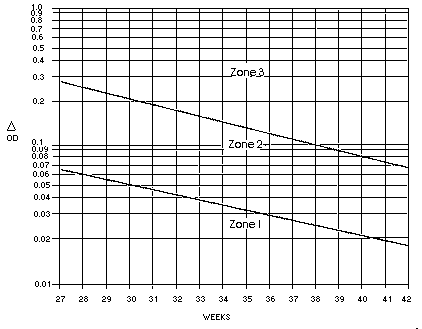
Archived File
Management of Rh Disease and Isoimmunization
http://www.obfocus.com/high-risk/Rh_disease/rh_diseasepr.htm
|
The numerous antigens on
the surface of red blood cells have been placed into groups. Many people
are familiar with the Rhesus (Rh) group as it is the most clinically relevant.
However the non-Rh groups such as Kell,
MNS,
and Kidd
have assumed increasing importance as the incidence of Rh-D sensitization
has decreased. Nonetheless sensitization to Rh antigens (non-D )
is still responsible for the largest proportion of hemolytic disease
in the newborn (HMD)[1].
According to the Fisher and
Race theory of inheritance [2] :
There are more than forty antigens in the Rh system including
weak D (formerly called Du
variant).
Mothers typed as weak D appear to be Rh negative on blood screening.
PathogenesisBlood production in the fetus begins at about 3 weeks' and Rh antigen has been identifed in the red cell membrane bas early as 38 days after conception. [6]
The reduced risk of Rh sensitization with ABO incompatibility may result from the rapid clearance of incompatible red cells thus reducing the overall exposure to D antigen. ScreeningInitial blood type and screening for antibodies is part of routine prenatal care. The evaluation of a positive antibody screen should include identification of the antibody and its titer.Identification of antibody [1,5,7 ]
Management[1,5,7 ]Rh-D Negative Unsensitized PatientsFor prevention of sensitization:
*Rh-immune globulin is an antibody that will help to remove any Rh positive cells in the mother's blood. Rh-immune globulin must be given before the mother begins to produce her own antibody to the Rh factor. In general the priniciples used in the management of the Rh-D negative sensitized patient and the management of the patient with atypical blood antibodies do not differ. First Sensitized Pregnancy (no prior severely affected pregnancy).
Previously Affected Pregnancy
Surveillance Serial Amniocentesis
Fetuses affected by hemolytic disease secrete abnormally high levels of bilirubin into the amniotic fluid. The amount of bilirubin can be quantitated by spectrophotometrically measuring absorbance at the 450-nm wavelength in a specimen of amniotic fluid that has been shielded from light.
Alternatively, percutaneous umbilical blood sampling (PUBS) may be used to determine all blood parameters directly.
The Liley Curve
The Liley curve is divided into three zones. Patients with results in zone I or low zone II can be allowed to proceed to term, at which point labor should be induced. In most cases, patients in the middle of zone II can progress to 36-38 weeks of gestation. Depending on gestational age, patients in zone III should either be delivered or should receive intrauterine fetal transfusion. Although serial determinations of Delta optical density at 450 nm and PUBs are the most common methods for the evaluation of fetal status, Doppler ultrasonography of the middle cerebral artery has also been used to identify fetuses at risk for moderate to severe hemolytic disease. Expected Peak Velocity of Systolic Blood Flow through MCA (calculator) [9, 10] Tranfusion Protocol (calculator) Lastly, in women with extremely high titers ( > 256), at less than 28 weeks, where the fetus does not demonstrate hydrops, and there is a documented history of fetal death due to hydrops intravenous immune serum globulin (IVIG) might be offered. The dose is 400 mg/kg per day for 5 days, with repeat infusions every 15 to 21 days. Specific contraindications to intravenous immunoglobulin use include a previous episode of intravenous immunoglobulin-induced anaphylaxis (rare) and selective IgA deficiency. [12, 13] REFERENCES
2. Race RR. The Rh genotype and Fisher's theory. Blood (Special Issue No 2) 1948;3:27
3. Masouredis SP:Realtionship between Rho(D) genotype and quantitiy of I131 anti-Rho(D) bound to red cells. J Clin Invest 39:1450,1960
4. Lacey PA et al. Fatal hemolytic disease of the newborn due to anti-D in anRH positive Du variant mother. Transfusion 1983;23:91
5. John M Bowman. Maternal Alloimmunization and Fetal Hemolytic Disease. In: Reece
EA et al (eds), Medicine of the Fetus and Mother.Philadelphia ,J.B Lippincott, 1992.
6.Bergstrom H et al. :Demonstration of Rh antigens in a 38-day-old fetus. Am J Obstet Gynecol 99:130,1967.
7.Michael L. Socol. Management of Blood Group Isoimmunization. In: Gleicher
N et al (eds), Principles and Practice of Medical Therapy in Pregnancy.New York ,
Appleton & Lange, 1998.
8. Copel JA, Scioscia A, Grannum PA, Romero R, Reece EA, Hobbins JC. Related Articles Percutaneous umbilical blood sampling in the management of Kell isoimmunization.
Obstet Gynecol. 1986 Feb;67(2):288-90.
9. Collaborative Group for Doppler Assessment of the Blood Velocity in Anemic Fetuses. N Engl J Med. 2000 Jan 6;342(1):9-14.
10. Mari G, Adrignolo A, Abuhamad AZ, et al. Diagnosis of fetal anemia with Doppler ultrasound in the pregnancy complicated by maternal blood group immunization. Ultrasound Obstet Gynecol 1995;5:400-5.
11. Liley AW. Liquor amnii analysis in management of pregnancy complicated by rhesus immunization. Am J Obstet Gynecol 1961;82:1359
12. Margulies M, Voto LS, Mathet E, Margulies M. High-dose intravenous IgG for the treatment of severe rhesus alloimmunization. Vox
13. Porter TF, et al Intravenous immune globulin in the management of
severe Rh D hemolytic disease.Obstet Gynecol Surv. 1997;52:193-7. |
||||||||||||||||||
|
Resources:
|
Please review the
Disclaimer before using this site.
Copyright © 2002-2004 by Focus Information Technology. All rights reserved.
The information provided on this site is updated periodically. It is likely that the information presented will not include all information currently available. Keep in mind the limitations of this information.
Archived: 2/14/2004